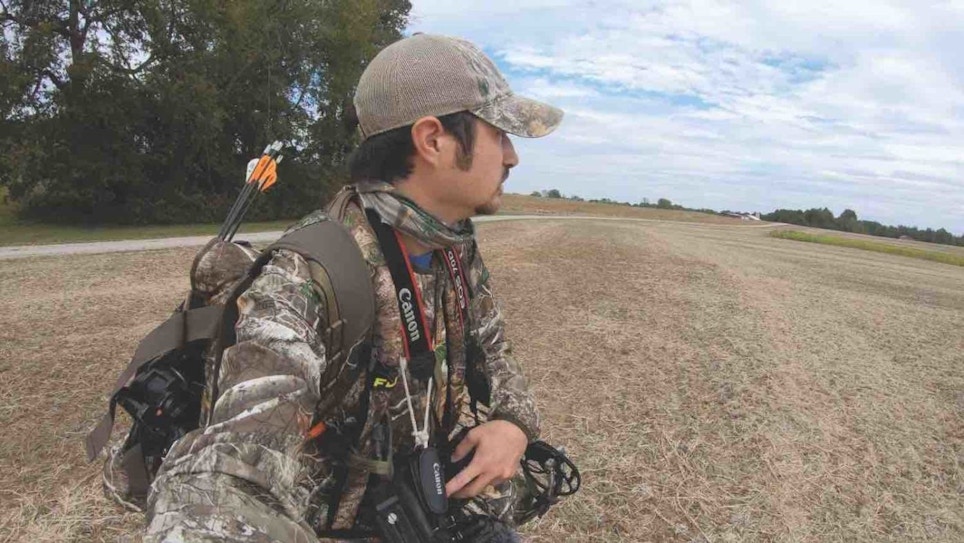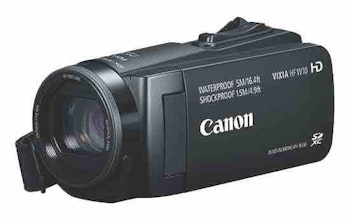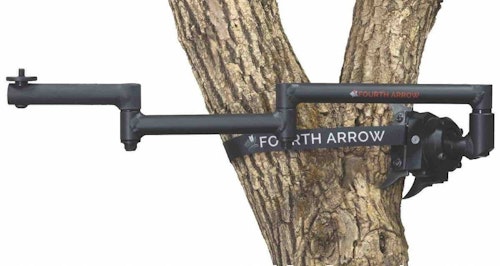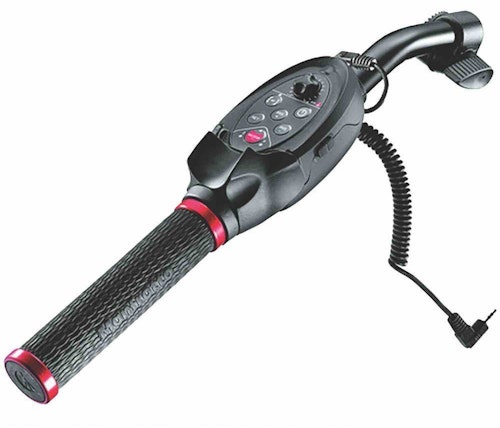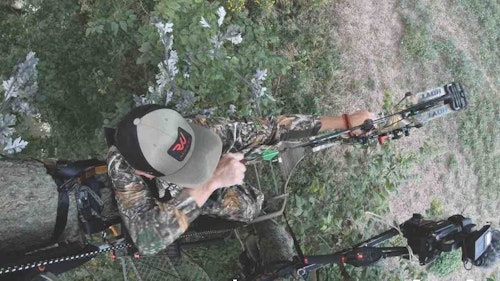Sweat dripped like rain from my face and landed on the treestand platform around my feet. I carefully manned the camera LANC remote, ensuring the giant velvet buck remained framed well. Minutes seemed like hours as I filmed him and his bachelor group feed in the open field. Finally, the whitetails marched toward me, and the real fun began.
Bow in my left hand, LANC remote in my right, I tracked the deer’s movement with both, keeping everything pointed directly at the target deer. Then, just before the deer entered my shooting lane, I positioned the camera for the shot, clipped my release aid on the string, and drew back. The buck stopped, the arrow flew, all of which culminated into the greatest self-filmed hunt I’ve ever produced.
Overall, dozens of my self-filmed hunts have appeared on Midwest Whitetail, Monster Bucks, North American Whitetail, and other digital outlets. In fact, the large velvet 8-pointer mentioned here was self-filmed, too, and a photo of the buck made the back cover of a Monster Bucks DVD. That was a dream come true for me.
There’s no doubt many of your archery shop customers would like to self-film their bowhunts. Of course, in order to talk intelligently about this topic on the sales floor, you and your staff must be informed on the required gear and how to use it before you can pass along this knowledge to customers. Here’s what bowhunters need to know for capturing a high-quality, self-filmed hunt on camera.
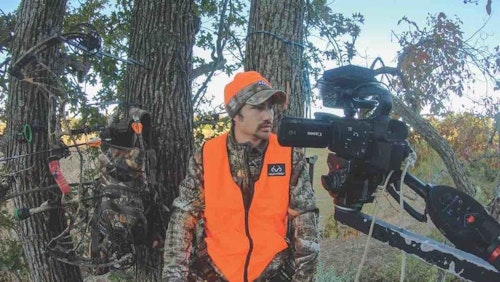
Primary Camera
Those who consistently self-film hunts with a high degree of success know one thing — you can’t do it with a DLSR or mirrorless camera. These cameras can oftentimes capture better photos and videos, but they also take two hands to run effectively, and you don’t have that when self-filming, especially within proximity to deer, turkey and other game. You need to be able to hold your bow in one hand, and run the camera with the other, especially just prior to drawing and shooting. To do this, a camcorder style camera is best. The compact, lightweight nature of camcorders is needed, too.
There are numerous camera companies that make great products, including Canon, Nikon, Sony and more. Because I’ve used Canon products for the past 10 years, I’ll focus more on these. I’ll also focus on the low- to mid-range cameras, which run from a few hundred dollars on the low end to $3,000 on the high side. Of course, there are even more expensive cameras available, but most hunters won’t drop that much cash on their first, or even second, camera.
I don’t recommend stocking a big number or wide variety of cameras. Remember: You and your staff must learn how to use them in order to teach your customers. At a minimum, stock a handful of the lowest priced Canon suggested below, and perhaps a couple of the next higher priced model, too.
Canon Vixia HF W10: This camera is an excellent entry-level option for someone who wants to dip their toes in the water, literally and metaphorically. It’s waterproof in up to 16.4 feet of water, and shockproof up to 4.9 feet. It’s also dustproof and freezeproof down to 14 degrees Fahrenheit. It shoots full HD 1920x1080 footage (AVCHD format), includes 40x optical zoom, has built-in memory, has a long battery life, and more. MSRP: $349.99
Canon XA40: The Canon XA40 is an excellent camera, especially for its price point. It’s a professional grade camera and has very quick capture and transmission capabilities. It comes loaded with features, including an advanced 4K UHD CMOS Pro Image Sensor with great low-light performance, a 20X optical zoom, dual SD slots, simultaneous dual recording, slow and fast motion recording, full manual control, dual phantom powered XLR audio inputs, detachable handle with controls, assignable buttons, infrared shooting, and more. MSRP: $1,599
Canon XA50: The Canon XA50 is a step up from the XA40. While this camera has more bells and whistles, I prefer the XA40, simply due to its greater optical zoom. That said, some say the XA50 does slightly better in low-light conditions, which bowhunters commonly face. The XA50 has plenty to offer, including 4K UHD and full HD recording, dual SD card slots, a 15X optical zoom, slow and fast motion recording, dual XLR audio inputs, detachable handle with controls, and more. MSRP: $2,299
Second-Angle Camera
Those who self-film will likely want at least one alternate angle camera. GoPro is the absolute best option for this. If you have one GoPro, I recommend mounting it behind you, capturing both you and the animal. If you have two GoPros, mount the second one on top of the primary camera so you have a zoomed-in clip (primary camera) and wide-angle shot (GoPro) of the hunt.
My advice on what to stock for GoPros is similar to that of camcorders. Pick one or two models, learn how to run them, and don’t overbuy.
GoPro Hero8: The GoPro Hero 8 has a little age on it now, but it’s still a killer camera. It offers a lot, including 4K videos, a waterproof design (up to 33 feet), HyperSmooth 2.0 video stabilization, and more. It’s compatible with 30-plus mounts and accessories. MSRP: $279.98
GoPro Hero9: The GoPro Hero 9 is a little newer, and offers even more. It delivers crisp, 5K video, HyperSmooth 3.0 stabilization, a waterproof design, detachable lens, front and rear screens, etc. It’s even compatible with 30-plus mounts. MSRP: $349.98
GoPro Hero10: The Hero10 Black by GoPro is another excellent option. It has the new GP2 processor, shoots 5.3K videos with double the frame rate, has enhanced low-light performance, offers HyperSmooth 4.0 stabilization in all modes, and more. It too is compatible with 30-plus mounts and accessories. MSRP: $349.98
Tree Arm
Those who deer hunt from a treestand will need a tree arm to hold their camera. It’s completely necessary for those who plan to self-film, and even those who film others. It’s the only way to stabilize the camera, especially with hands-free operation.
Muddy Hunt Hard Camera Arm: The Hunt Hard Camera Arm by Muddy is an excellent option. It’s easily packable and sets up quickly. It comes with a bubble level, ratchet strap, and more. It weighs 5 pounds and has a 6-pound weight rating. MSRP: $99.99
Fourth Arrow Stiff Arm: Those who want a lighter arm might consider the Stiff Arm by Fourth Arrow. It weighs only 1 pound 13 ounces. It also has a 32-inch length, total reach of 38 inches, and a weight rating of 10 bounds (or 8 pounds with the talon). This kit includes the arm, 3.0 Shoulder, 3.0 Base (or Talon), and ratchet strap. MSRP: $219.99
Fourth Arrow Talon Micro Triple Arm: Those who want a Fourth Arrow arm with even less weight might consider the Talon Micro Triple Arm. It weighs 1 pound 1 ounce, and weighs 3 pounds 10 ounces including the entire kit, which consists of the shoulder, talon, ratchet, and arm. It has a total reach of 29 inches and a weight rating of 10 pounds. MSRP: $279.99
Monopod/Tripod
Those who hunt from the ground must purchase a monopod and/or a tripod. Personally, I prefer the stability of a tripod. However, these can be bulky and weigh a lot. Those who want less weight, and perhaps need to be more mobile, might consider a monopod with a higher end, three-pronged base system that can reliably stand on its own, even in rugged terrain. Manfrotto, Neewer and Sirui have some of the best offerings on the market.
Fluid Head
Everyone should consider a good fluid head for their tree arm and monopod/tripod. This will make for better, more fluid motions than the standard attachment that oftentimes comes with these. There are numerous companies who make great fluid heads, including Benro, Manfrotto, etc.
LANC Remote
A LANC remote is crucial for all cameramen, but especially those who self-film with a camcorder. Depending on the specific model, this can allow you to adjust focus, zoom in and out, record, and more. Personally, I prefer and use the Manfrotto RC Pan Bar EX Remote Control for Canon and Sony cameras with LANC port. MSRP: $356.99
Shotgun Mic
Those who want to capture all the ambient sounds during the hunt should consider a shotgun mic. This will not only capture good audio of you talking, but also all the other sounds that go into filming a hunt. Don’t underestimate the power of great audio. Without it, you’ll have a poor finished product, even if the video footage is good. There are many good options. If you plan to run a wireless mic, and your camera model has dual XLR ports, find a mic with XLR compatibility. Select one of many great options on the market.
Wireless Mics
For the very best audio of yourself, it’s important to use a wireless mic. This can be cumbersome, but it’s essential for the best audio experience. Fortunately, if your camera has dual XLR inputs, you can purchase a wireless mic that also has XLR capabilities. Then, you’ll be able to simultaneously run a shotgun and wireless mic. Choose one of numerous great selections currently available.
Miscellaneous Items
In addition to the main items, there are other things you’ll need as well. Lights for filming recoveries after dark. Cleaners for when your camera bodies and lenses inevitably get dirty. Extra batteries for when the cold zaps your main one, or when you forget to recharge the night before the hunt. These products and more are also necessary to use when self-filming hunts.
Backpack
Don’t forget the need of a good backpack. You can’t self-film if you can’t carry all this gear afield. You need a large pack that’s also comfortable and quiet. In my experience, one of the best options is the Insights The Vision pack. I use the bow/firearm pouch to hold large camera gear, such as tree arms and tripods, and internal pockets for the camera and other equipment. There’s still enough room for most of my important hunting gear items, too. It retails for $219.99.
Final Thoughts
Assuming you’ve attended the ATA Show in the past, you’ve seen the saddle and treestand companies with a tree trunk section mounted in their booth to display their products. This is the best way to showcase self-filming products in your shop, too. This will give customers a first-hand look at how all the elements work in concert.
Regardless of the equipment you decide to stock in your shop, it’s crucial to communicate to customers that self-filming is no easy task. It requires a constant battle of having grit and losing your sanity, because it will test your sanity. But when you self-film the perfect hunt, and have that memory to look back on, it’s worth all of the time, effort and trouble.
Sidebar: The Shot List
It’s crucial to shoot enough footage to tell the entire story. While this isn’t an exhaustive list, these are some of the most important shots to capture. Some of the supporting and cutaway shots can be captured with alternate-angle cameras, but all interviews and crucial footage should be taken with the primary camera. Remember, if it’s part of the hunt, then family, friends and other viewers will want to see it. Paint an accurate, truthful picture with video and audio.
Interviews
- An intro that opens the hunt and explains the situation to the audience
- Periodical updates throughout the hunt that update the viewer
- A post-hunt close that recaps the hunt
- Interviews with hunters after they tag animals
Crucial Footage
- Clips of non-target animals
- Clips of targeted game animals
- Pan shots of landscape
- Clips of key landscape features
- Pre-roll video of harvested animal
- The shot
- Post-shot movement of animal
- Post-shot reaction from hunter
- Recovery of animal
Cutaway/Supporting Footage
- Prepping gear
- Walking to treestand or blind
- Pulling up gear into stand
- Setting up gear (nocking arrow, hanging bow, etc.)
- Calling and rattling
- Glassing with bino
- Using rangefinder
- Reactions to seeing wildlife
- Release aid on string
- Drawing bow
- Aiming bow
- Packing gear
- Descending tree or exiting blind
- Retrieving arrow
- Putting arrow in quiver
- Observing blood trail
- The blood trail
- Various shots of recovered game, etc.
In-the-field photos by Honeycutt Creative LLC
